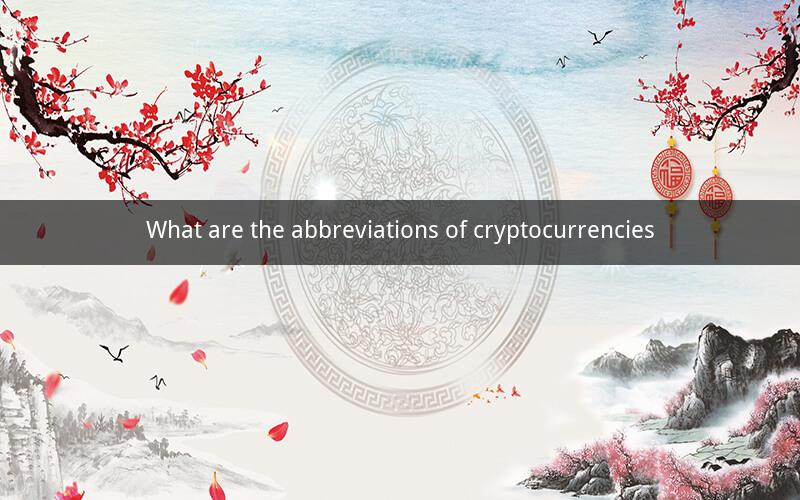
Cryptocurrency Abbreviations: A Comprehensive Guide
Table of Contents
1. Introduction to Cryptocurrency Abbreviations
2. Common Cryptocurrency Abbreviations
2.1 BTC
2.2 ETH
2.3 LTC
2.4 XRP
2.5 BNB
2.6 ADA
2.7 DOT
2.8 NEO
2.9 XMR
2.10 LTC
2.11 BCH
2.12 ZEC
2.13 ETC
2.14 DASH
2.15 OMG
2.16 MKR
2.17 GNT
2.18 REP
2.19 BNB
2.20 EOS
3. Abbreviations in Cryptocurrency Exchanges
4. The Importance of Cryptocurrency Abbreviations
5. Conclusion
1. Introduction to Cryptocurrency Abbreviations
Cryptocurrency abbreviations are shortened forms of the names of various digital currencies. These abbreviations are widely used in the cryptocurrency community to make communication more efficient and concise. In this guide, we will explore the most common cryptocurrency abbreviations and their meanings.
2. Common Cryptocurrency Abbreviations
2.1 BTC
BTC stands for Bitcoin, which is the first and most well-known cryptocurrency. It was created in 2009 by an anonymous person or group of people using the pseudonym Satoshi Nakamoto.
2.2 ETH
ETH represents Ethereum, a decentralized platform that enables the creation of smart contracts and decentralized applications (DApps). It was launched in 2015 by Vitalik Buterin.
2.3 LTC
LTC stands for Litecoin, a cryptocurrency that was created as a fork of Bitcoin in 2011. It aims to be a faster and more efficient alternative to Bitcoin.
2.4 XRP
XRP is the native cryptocurrency of the Ripple network, a platform designed for the settlement of financial transactions. It focuses on low-cost and high-speed international money transfers.
2.5 BNB
BNB is the native cryptocurrency of Binance, one of the largest cryptocurrency exchanges in the world. It was launched in 2017 and is used for various purposes, including transaction fees and participation in the exchange's governance.
2.6 ADA
ADA stands for Cardano, a blockchain platform that aims to offer a more secure and scalable solution compared to other cryptocurrencies. It was founded by Charles Hoskinson, one of the co-founders of Ethereum.
2.7 DOT
DOT represents Polkadot, a multi-chain system that enables different blockchains to connect and share their resources. It aims to improve the efficiency and interoperability of blockchain networks.
2.8 NEO
NEO is the native cryptocurrency of the NEO network, a Chinese blockchain platform that focuses on the development of a smart economy. It was launched in 2014 and is often referred to as "China's Ethereum."
2.9 XMR
XMR stands for Monero, a privacy-focused cryptocurrency that aims to provide users with complete anonymity. It was created as a fork of Bitcoin in 2014.
2.10 LTC
LTC is an abbreviation for Litecoin, which we have already discussed in section 2.3.
2.11 BCH
BCH stands for Bitcoin Cash, a cryptocurrency that was created as a fork of Bitcoin in 2017. It aims to offer faster transaction speeds and lower fees.
2.12 ZEC
ZEC represents Zcash, a privacy-focused cryptocurrency that aims to provide users with complete anonymity. It was created as a fork of Bitcoin in 2016.
2.13 ETC
ETC stands for Ethereum Classic, a fork of Ethereum that aims to restore the original vision of the Ethereum platform. It was created in 2016 as a result of a disagreement on the Ethereum community.
2.14 DASH
DASH stands for Dash, a cryptocurrency that aims to provide fast and private transactions. It was launched in 2014 and is often referred to as "digital cash."
2.15 OMG
OMG stands for OmiseGO, a platform that aims to enable real-time settlements of financial transactions across different currencies and assets. It was launched in 2016.
2.16 MKR
MKR represents Maker, a decentralized platform that aims to provide a stable cryptocurrency called DAI. It was launched in 2015 and is based on the Ethereum blockchain.
2.17 GNT
GNT stands for Golem, a decentralized marketplace that aims to provide computing power as a service. It was launched in 2016 and is based on the Ethereum blockchain.
2.18 REP
REP stands for Rep.ai, a platform that aims to provide a decentralized platform for creating and running AI applications. It was launched in 2016 and is based on the Ethereum blockchain.
2.19 BNB
BNB is an abbreviation for Binance Coin, which we have already discussed in section 2.5.
2.20 EOS
EOS stands for EOS.IO, a blockchain platform that aims to provide a decentralized operating system for creating and deploying decentralized applications. It was launched in 2017.
3. Abbreviations in Cryptocurrency Exchanges
Cryptocurrency exchanges often use these abbreviations to list and identify different cryptocurrencies. This helps users quickly recognize and access the cryptocurrencies they are interested in.
4. The Importance of Cryptocurrency Abbreviations
Cryptocurrency abbreviations play a crucial role in the cryptocurrency community. They make communication more efficient, reduce the risk of confusion, and help users quickly understand the context of discussions. Moreover, they are essential for navigating cryptocurrency exchanges and understanding market trends.
5. Conclusion
Understanding cryptocurrency abbreviations is vital for anyone interested in the cryptocurrency space. By familiarizing yourself with the common abbreviations, you can effectively communicate, navigate exchanges, and stay informed about the latest trends. In this guide, we have explored the most common cryptocurrency abbreviations and their meanings, providing a comprehensive reference for the cryptocurrency community.
---
Related Questions
1. What is the difference between BTC and ETH?
2. Can you explain the concept of a fork in cryptocurrency?
3. How does the Ripple network work?
4. What are smart contracts, and how are they used?
5. What makes Monero different from other cryptocurrencies?
6. How does the Cardano platform aim to improve blockchain technology?
7. What is the purpose of the Polkadot network?
8. How does Binance Coin (BNB) contribute to the Binance exchange?
9. What is the significance of the Ethereum Classic (ETC) network?
10. How does the OmiseGO platform aim to revolutionize financial transactions?